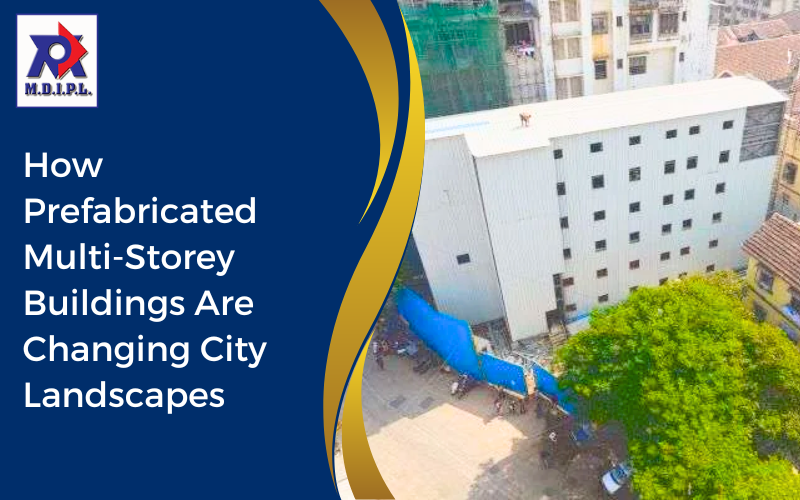As urbanization continues to accelerate around the globe, cities face a myriad of challenges, from housing shortages to environmental sustainability. In this dynamic landscape, one solution is emerging as a game-changer: prefabricated multi-storey buildings. At MDIPL, we are at the forefront of this revolution, utilizing innovative construction methods that not only meet the demands of modern urban life but also enhance the aesthetic and functional qualities of our cities.
Understanding Prefabricated Multi-Storey Buildings
Prefabricated buildings, or “prefabs,” are constructed off-site in a factory setting before being transported and assembled at the final location. This method streamlines the building process, allowing for faster construction times, reduced labor costs, and improved quality control. Multi-storey prefabricated buildings take this concept to new heights—literally—providing efficient, space-saving solutions for urban living.
The Benefits of Prefabricated Construction
- Speed of Construction: One of the most significant advantages of prefabricated buildings is the speed at which they can be erected. Traditional construction methods can take months or even years to complete, while prefabricated structures can often be assembled in a fraction of that time. This rapid turnaround is crucial in addressing urgent housing demands in growing cities.
- Cost-Effectiveness: Prefabrication reduces construction costs by minimizing labor requirements and material waste. By producing components in a controlled environment, manufacturers can optimize the use of resources and pass these savings on to developers and, ultimately, homeowners.
- Sustainability: As cities strive to become more environmentally friendly, Prefabricated Multi-Storey Buildings offer a sustainable alternative. Many prefab manufacturers, including MDIPL, prioritize eco-friendly materials and energy-efficient designs, significantly reducing the carbon footprint associated with traditional construction methods.
- Quality and Safety: Off-site manufacturing allows for stricter quality control compared to on-site construction. Components are produced in a consistent environment, which minimizes the risk of defects and ensures that safety standards are met. Additionally, the reduction of on-site construction activities can lead to safer working conditions for laborers.
- Design Flexibility: Modern Prefabricated Multi-Storey Buildings can be customized to meet a wide range of architectural styles and functional needs. Whether it’s residential apartments, office spaces, or mixed-use developments, prefab construction offers the flexibility to adapt to various urban landscapes.
Transforming Urban Landscapes
The impact of Prefabricated Multi-Storey Buildings on city landscapes is profound. Here’s how they are reshaping our urban environments:
1. Maximizing Space
As urban populations swell, the demand for housing and commercial spaces in city centers is at an all-time high. Prefabricated multi-storey buildings allow for efficient land use, enabling cities to accommodate more people without expanding their geographic footprint. This vertical growth promotes a more compact, connected urban fabric.
2. Creating Vibrant Communities
With their versatile designs, prefabricated buildings can contribute to vibrant neighborhoods. Mixed-use developments that combine residential, commercial, and recreational spaces foster community interaction and enhance the urban experience. This integration can lead to more walkable cities where residents can access amenities without the need for cars.
3. Aesthetic Appeal
Gone are the days when prefabricated buildings were synonymous with bland, industrial aesthetics. Today’s prefabs can be stylish and architecturally appealing. Innovative designs and high-quality materials allow for creative expressions that can enhance the visual landscape of a city. At MDIPL, we are dedicated to ensuring our structures not only meet functional needs but also contribute to the beauty of their surroundings.
4. Resilience in Urban Planning
In a world increasingly affected by climate change and natural disasters, the resilience of urban infrastructure is paramount. Prefabricated buildings can be designed to withstand various environmental challenges, from seismic activity to flooding. Their rapid construction also allows for quicker recovery in disaster-stricken areas, providing essential housing and services when they are most needed.
The Future of Urban Development with MDIPL
At MDIPL, we believe that prefabricated multi-storey buildings are more than just a trend; they represent the future of urban development. As we continue to innovate and expand our offerings, we remain committed to sustainability, efficiency, and community-focused design.
Our projects reflect a holistic approach to building—one that considers not just the immediate needs of residents but also the long-term impact on the environment and urban ecosystems. By embracing prefabrication, we are not only transforming city landscapes but also paving the way for smarter, more sustainable living.
Conclusion
The rise of prefabricated multi-storey buildings is revolutionizing urban landscapes, providing practical solutions to the pressing challenges of modern city life. As urbanization accelerates, the need for innovative construction methods becomes ever more critical. At MDIPL, we are excited to be part of this transformative journey, harnessing the power of prefabrication to create spaces that are not only functional and cost-effective but also beautiful and sustainable.


